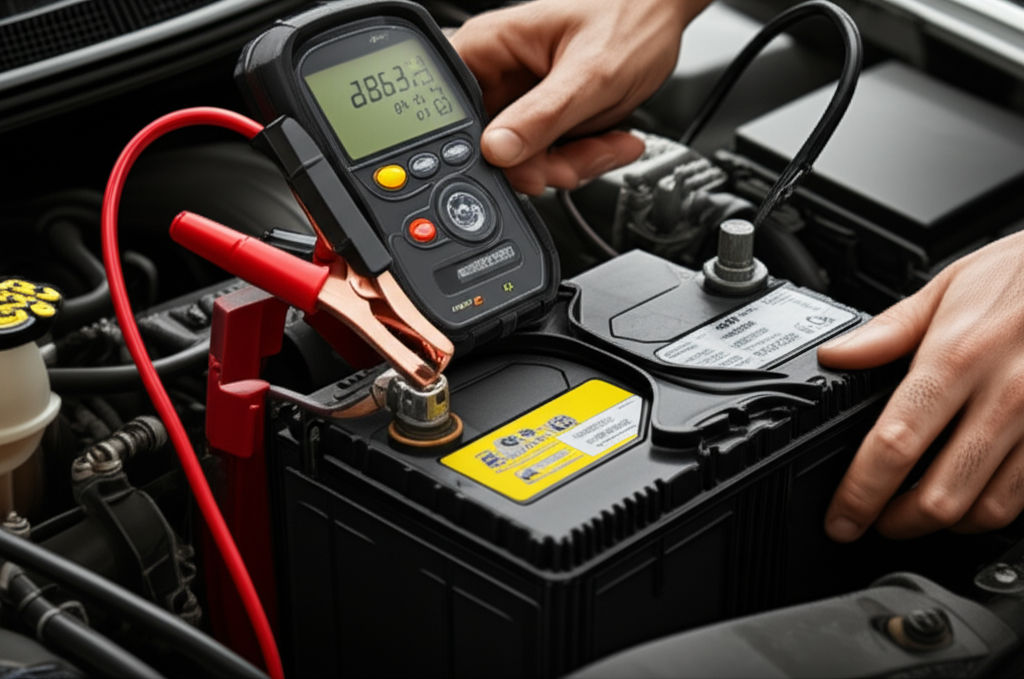How To Use An Automotive Battery Tester
Ellie Moore

Photo: Unlock your car's power! Learn to use an automotive battery tester to diagnose battery health, prevent breakdowns, and save money.
Unlock Your Car's Power: A Comprehensive Guide to Using an Automotive Battery Tester
Few things are as frustrating as a dead car battery, especially when you're in a hurry. While a jump start might get you going, it doesn't address the underlying issue. Understanding your car's battery health is crucial for reliable vehicle performance and avoiding unexpected breakdowns. This is where an automotive battery tester becomes your best friend. It's a powerful diagnostic tool that allows you to assess your battery's condition, identify potential problems early, and make informed decisions about maintenance or replacement.
In this in-depth guide, we'll demystify the process of using an automotive battery tester, explore different types of testers, help you interpret the results, and offer practical tips to keep your car's power source in top shape.
Why Testing Your Car Battery is Essential
Many drivers mistakenly view their car battery as a "set it and forget it" component, only paying attention when it fails. However, regular battery testing is a proactive measure that offers significant benefits:
- Preventing Unexpected Breakdowns: A failing battery is a leading cause of vehicle breakdowns. Testing allows you to catch issues before they leave you stranded.
- Saving Money: Identifying a weak battery early means you can recharge it or perform maintenance, potentially extending its life and delaying costly replacements.
- Ensuring Reliability: A healthy battery ensures your vehicle starts reliably, especially in extreme weather conditions where battery performance is significantly impacted.
- Diagnosing Charging System Issues: Battery testers can also provide clues about your vehicle's charging system, like the alternator, which is responsible for recharging the battery while you drive.
Modern vehicles, with their increasing number of electrical components and features like start-stop systems, place greater demands on the battery, making regular checks more critical than ever.
Types of Automotive Battery Testers
Before diving into the "how-to," it's helpful to understand the different kinds of automotive battery testers available. Each type offers varying levels of detail and complexity:
1. Voltmeters / Multimeters
These are basic tools that measure the battery's voltage. A digital multimeter can measure multiple electrical quantities, including voltage, current, and resistance. While simple to use, a voltmeter primarily tells you the battery's state of charge (SOC) or resting voltage. It doesn't provide a full picture of the battery's overall health or its ability to deliver power under load.
- Pros: Inexpensive, widely available, easy to use for basic voltage checks.
- Cons: Limited diagnostic capability, doesn't assess internal resistance or cranking ability.
2. Load Testers (Carbon Pile Testers)
Traditional load testers work by applying a significant electrical load to the battery, simulating the stress of starting an engine. This method assesses the battery's ability to deliver power under real-world conditions. Many older mechanics still consider this the "gold standard" for battery testing.
- Pros: Provides an accurate assessment of the battery's capacity to deliver current under load.
- Cons: Can be bulky, requires the battery to be at least 85% charged for accurate results, and can be more complex to use for the average DIYer. Improper use can also damage the battery.
3. Digital Battery Testers (Conductance Testers)
These are the most common and recommended automotive battery testers for general use. They employ conductance or resistance technology to quickly assess battery health without fully discharging it. They measure internal resistance and cold cranking amps (CCA), providing a comprehensive diagnosis in a matter of seconds. Many models, like the Ancel BA101, are highly regarded for their accuracy and ease of use for non-professionals.
- Pros: Fast, safe, easy to use, provides detailed information like CCA, voltage, internal resistance, and state of health (SOH). Many models are compatible with various battery types (flooded, AGM, gel).
- Cons: Generally more expensive than a simple voltmeter.
For the purpose of this guide, we'll focus on the digital automotive battery tester as it offers the best balance of accuracy, user-friendliness, and comprehensive diagnostics for the average car owner.
Getting Started: Safety First!
Working with car batteries involves electricity and corrosive chemicals, so safety is paramount. Always prioritize these precautions:
- Wear Personal Protective Equipment (PPE): Always wear ANSI Z-87.1 splash-proof safety goggles to protect your eyes from potential acid splashes or explosions. Gloves are also recommended.
- Ensure Proper Ventilation: Batteries can release hydrogen gas, which is highly flammable. Work in a well-ventilated area to prevent gas buildup.
- No Open Flames or Sparks: Keep cigarettes, lighters, matches, and any sources of sparks away from the battery. A spark can ignite hydrogen gas and cause an explosion.
- Avoid Leaning Over the Battery: Never lean directly over the battery when testing or jump-starting, even with safety goggles on, as an explosion could cause serious injury.
- Check for Battery Damage: Before testing, visually inspect the battery for any cracks, bulges, leaks, or excessive corrosion. If you notice significant damage, do not test it; the battery needs to be replaced.
- Vehicle Off and in Park/Neutral: Ensure your vehicle's engine is off and the parking brake is engaged (or in neutral for manual transmissions) to prevent accidental movement.
Step-by-Step Guide: How to Use a Digital Automotive Battery Tester
Using a digital battery tester is straightforward. Follow these steps for an accurate reading:
Step 1: Prepare the Battery
- Turn off the Vehicle: Ensure the engine is off and all accessories (lights, radio, etc.) are turned off. This allows the battery to rest and provides a more accurate reading. Ideally, let the battery sit idle for at least an hour before testing for the most accurate "resting voltage."
- Locate the Battery: Most car batteries are under the hood, but some vehicles may have them in the trunk or under a rear seat.
- Clean the Terminals: Corrosion (often a white or greenish-white powdery buildup) on the battery terminals can impede electrical flow and affect test results. Use a wire brush or a battery terminal cleaning tool and a solution of baking soda and water to clean them. Ensure the terminals are clean and dry before proceeding.
Step 2: Connect the Battery Tester
- Identify Terminals: Locate the positive (+) and negative (-) terminals on your battery. The positive terminal is usually larger and marked with a plus sign, while the negative is smaller and marked with a minus sign.
- Connect Clamps: Attach the red (positive) clamp of your battery tester to the battery's positive (+) terminal. Then, attach the black (negative) clamp to the battery's negative (-) terminal. Ensure a secure connection. Incorrect connection can cause a short circuit or test failure.
Step 3: Configure the Tester (If Applicable)
- Select Battery Type: Many digital testers require you to select the type of battery you're testing (e.g., standard flooded, AGM, Gel, EFB). This is crucial as different battery types have different testing algorithms.
- Input CCA Rating: Your battery's Cold Cranking Amps (CCA) rating is usually printed on a label on the battery itself. Input this value into the tester when prompted. Some testers also ask for the measurement standard (e.g., SAE, EN, DIN, JIS, IEC).
Step 4: Run the Test
- Initiate Test: Follow the instructions on your specific battery tester to start the diagnostic process. Most digital testers provide a quick reading within seconds.
- Observe Results: The tester's display will show the test results, often including voltage, CCA, internal resistance, and a "State of Health" (SOH) or "State of Charge" (SOC) percentage.
Step 5: Disconnect the Tester
- Remove Clamps: Once the test is complete and you've noted the results, carefully remove the negative (black) clamp first, followed by the positive (red) clamp.
Interpreting Your Battery Tester Results
Understanding what the numbers mean is key to determining your battery's health. Here are the primary readings you'll encounter:
1. Voltage Reading
- What it is: The basic measurement of the battery's electrical potential.
- Healthy Range (Engine Off): A fully charged 12V car battery should read around 12.6 to 12.8 volts after sitting idle for several hours.
- What it means:
- 12.4V or less: Indicates a partially discharged battery that needs recharging.
- Below 12.0V: Often a sign of a dead or significantly discharged battery that may need replacement.
- During Cranking: When starting the engine, the voltage shouldn't drop below 9.6 volts. A significant dip suggests
Finance & Investment
View All
April 19, 2025
RV Financing Calculator for Budget TravelersMaster expert SEO content to rank high, build authority, and drive online success. Learn to blend valuable information, UX, and optimization.
Ellie Moore

March 28, 2025
How Interest Rates Impact Asset ClassesLearn how changes in interest rates affect various asset classes, from stocks to bonds. Make informed decisions in changing markets!
Ellie Moore

March 31, 2025
Protect Your Portfolio in a Market DownturnDiscover strategies to safeguard your portfolio during market downturns. Learn how to minimize losses and thrive in uncertain times.
Ellie Moore

April 25, 2025
Defense Finance Accounting GuideMaster digital marketing with expert SEO content. Build authority (E-E-A-T), rank higher, engage your audience, and boost conversions for true success.
Ellie Moore

June 10, 2025
Understanding Finance Charges on LoansMaster expert SEO content! Learn to create high-ranking, user-centric articles that boost credibility, drive traffic, and satisfy Google's E-E-A-T.
Ellie Moore

April 7, 2025
SPY Yahoo Finance Market OverviewUnlock your online potential! Expert SEO content boosts rankings, builds trust (E-E-A-T), and attracts your ideal audience for business growth.
Ellie Moore
Insurance
View AllExplore emerging trends reshaping insurance in 2025. Stay ahead with insights on AI, blockchain, and coverage innovations.
Ellie Moore
Discover how lifestyle changes, like quitting smoking or driving less, can unlock insurance discounts. Start saving now!
Ellie Moore
Explore how your credit score affects insurance premiums. Learn how to improve your score and save on coverage!
Ellie Moore
Decode your insurance policy! Learn to understand terms, coverage, and conditions with this beginner-friendly guide.
Ellie Moore
Car accidents are costly. Our ultimate guide reveals how to secure comprehensive auto insurance, minimize financial risk, and gain essential peace of mind.
Ellie Moore
Protect yourself from online risks with cybersecurity insurance. Learn why it’s essential for individuals in a digital world.
Ellie Moore
Education
View AllDiscover how flipped classrooms work and why they’re becoming popular. Learn the key benefits of this innovative teaching approach.
Read MoreForest schools offer hands-on learning in nature. Discover how this approach nurtures creativity, problem-solving, and environmental awareness in students.
Read MoreLearn effective classroom strategies to manage ADHD. Discover how teachers can support students with ADHD for better learning outcomes.
Read MorePlay is crucial in early learning! Discover how play-based learning enhances cognitive, emotional, and social development in young children.
Read MoreTake learning beyond the textbook with experiential education. Discover how real-world experiences create lasting knowledge and skills.
Read MoreMOOCs are transforming the landscape of higher education. Learn how massive open online courses are making learning accessible to all.
Read MorePopular Post 🔥
View All
1
2
3
4
5
6
7
8
9
10
Health






Automotive
View All
July 27, 2025
Ingersoll Automotive Danbury Connecticut Services
Ingersoll Automotive Danbury offers expert, trusted service for Chevrolet, Buick, GMC & Cadillac. Experience quality car care.

July 17, 2025
Grote Automotive Products And Services Review
Grote Automotive: A century of innovation in vehicle safety & visibility. Discover trusted products for enhanced performance, reliability, and peace of mind.

August 25, 2025
How To Dispose Of Automotive Oil Safely
Don't dump it! Discover why safe automotive oil disposal is vital for the environment and how to recycle used motor oil properly.

September 10, 2025
Hometown Automotive Service With Heart
Discover the power of local auto service with heart. It's about trust, community, and personalized care that goes beyond just repairs.

July 20, 2025
Westin Automotive Innovations And Solutions
Explore Westin Automotive's legacy of innovation in truck, Jeep & SUV accessories. Discover quality products for protection, style & functionality.

September 1, 2025
How To Use An Automotive Battery Tester
Unlock your car's power! Learn to use an automotive battery tester to diagnose battery health, prevent breakdowns, and save money.

















